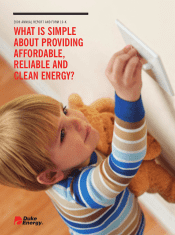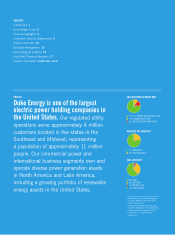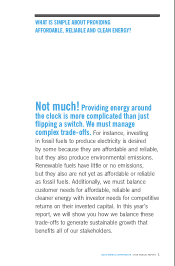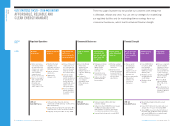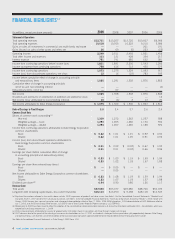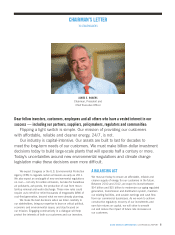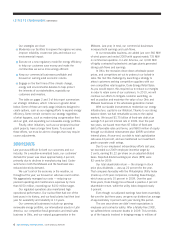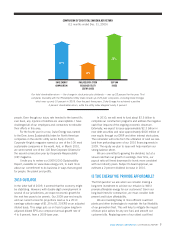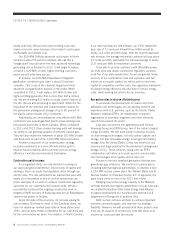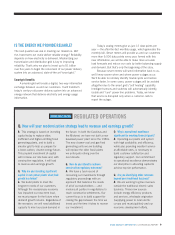Duke Energy 2009 Annual Report Download - page 9
Download and view the complete annual report
Please find page 9 of the 2009 Duke Energy annual report below. You can navigate through the pages in the report by either clicking on the pages listed below, or by using the keyword search tool below to find specific information within the annual report.
8 DUKE ENERGY CORPORATION / 2009 ANNUAL REPORT
LETTER TO STAKEHOLDERS (CONTINUED)
plants with new, efficient and lower-emitting coal units
makes economic sense because of our nation’s vast supply
of affordable and reliable coal.
Our 825-MW Cliffside advanced coal project in North
Carolina is about 55 percent complete. We call this a
“bridge plant” because when the new advanced-technology
generating unit is finished in 2012, it will begin to replace
a total of 1,000 MW of older, higher-emitting coal units,
which we will retire from service.
In Indiana, our 630-MW Edwardsport integrated
gasification combined-cycle plant is about 50 percent
complete. This is one of the cleanest, largest and most
advanced coal gasification projects in the world. When
completed in 2012, it will replace 160 MW of older and
higher-emitting generation that is more than half a century
old. We are investing $17 million to study carbon capture at
the site. We are also proposing to spend $42 million for the
first phase of site selection and characterization studies for
the permanent underground storage of up to 60 percent of
the plant’s carbon dioxide (CO2) emissions.
Additionally, we are building two very efficient 620-MW
combined-cycle natural gas-fired plants at two existing coal-
fired power plant sites in North Carolina. When completed
in 2011 and 2012, these cleaner-burning units will leverage
our ability to use growing supplies of domestic natural gas.
They will also enable the retirement of about 250 MW of older
coal-fired units as part of the 1,000 MW referenced above.
Another component of our modernization strategy
includes investments in a more efficient electric grid to
improve future reliability and to promote end-use energy
efficiency. I will discuss more about that below.
Constructive capital recovery
As a regulated utility, our only vehicle for earning on
our plant and grid investments is the recovery of capital and
earning a return on equity that regulators allow through our
electric rates. The rate settlements we reached last year with
nearly all of the parties in four of our five jurisdictions are
prime examples of our work to achieve constructive regulatory
outcomes for our customers and investors alike. We also
successfully continued the ongoing construction work in
progress (CWIP) recovery of financing costs for our Edwardsport
cleaner-coal project in Indiana.
Given the state of the economy, it’s not easy asking for
rate increases. But keep in mind, in the Carolinas alone, we
have not raised our nonfuel base rates in those states since
1991, and our rates remain competitive for our customers and
for the communities we serve. For instance, in North Carolina,
if our rates had kept up with inflation, our 1991 residential
base rate of 7.1 cents per kilowatt-hour (kWh) would be
nearly 11.2 cents per kWh today. With the recently approved
rate increase, the average residential customer will pay about
9.2 cents per kWh, well below the national average of nearly
11.8 cents per kWh for residential customers.
To be able to provide customers with affordable power,
we must seek and obtain constructive regulatory solutions
in all five of our state jurisdictions. As we are granted timely
recovery of our construction costs and expenses, and fair
returns on our equity capital, we will be able to raise new
capital at competitive and fair costs. Our regulatory framework
to expand energy efficiency will also help to reduce energy
costs, while earning fair returns for our investors.
New partnerships to advance affordable power
To accelerate the development of cleaner and more
affordable coal technologies, we are sharing research and
experience with U.S. partners, such as the Electric Power
Research Institute (EPRI), an independent, nonprofit
organization of scientists, engineers and other electricity
experts from around the world.
Last year, we entered into agreements with China’s
Huaneng Group and ENN Group, two of the nation’s largest
energy providers. We will work jointly to develop an array
of clean energy technologies, not only carbon capture and
storage, but also renewable energy, smart grid and battery
storage. Like the United States, China has enormous coal
reserves and huge potential for the permanent underground
storage of CO2. These ventures, along with our EPRI
collaboration, will allow us to scale up and commercialize
new technologies more rapidly, and at less cost.
Nuclear is the only baseload generation that has zero
greenhouse gas emissions. We continue to pursue plans,
including potential regional partnerships, to develop a new
2,234-MW nuclear power plant, the William States Lee III
Nuclear Station, in Cherokee County, S.C. If approved, the
plant could come on line in the 2021 time frame.
Bringing new nuclear energy capacity to the Midwest
will help diversify that region’s dependence on coal. Last year,
we created the Southern Ohio Clean Energy Park Alliance
to explore development of a nuclear power plant at a U.S.
Department of Energy site in southern Ohio.
Both nuclear ventures will help us achieve important
economic and policy goals, and maintain our strategic
flexibility. However, we will proceed with these projects only
if we can be assured of constructive rules that allow us to
recover our costs and earn fair returns.

